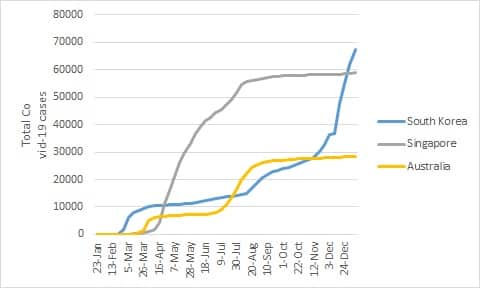Earlier this week I happened to walk by a central Sydney quarantine hotel and saw a mask-less police officer sitting at a trestle table in the lobby. For all the talk of stopping the boats and Border Force over the past two decades, Australia has done a mediocre job of border control when it actually really mattered.
But what about countries taking the situation more seriously? Last month we looked at Vietnam’s border control regime, and today we’re going to see how South Korea is getting it done.
South Korea has recently seen a sharp rise in coronavirus cases, but is still faring far better than the Atlantic countries.

Seoul-based journalist Raphael Rashid documented the entry procedures in his return trip between Korea and the UK. Arriving in the UK, Rashid was left to his own devices. He didn’t need to self-isolate, having arrived from Korea, despite actually flying Seoul – Dubai – UK, with the final leg obviously including passengers from all over the world. Many on the plane were not wearing masks, and even airport staff in London were often not even wearing a mask, let alone full-body protective equipment.
From his plane landing in Seoul to arriving at home for 14 days of self-isolation took “well over 24 hours,” according to Rashid. Passengers arriving in Korea need a negative test certificate to even get on the plane. Yet that is far from the of the matter.
Upon arrival, Rashid was told to throw away his mask, given a new and better one, then had his temperature taken and was tested again for SARS-CoV-2, right outside the plane on the mid-winter tarmac.
The new arrivals were then taken to sit in individual booths, filled out more paperwork, then made to install a quarantine app. Officials watched them enter their passport numbers and phone numbers into the app, then called the phone numbers to ensure they were valid.
They then passed through immigration, where the negative test certificate was re-verified, and escorted to collect their baggage. All officials wore full personal protective equipment at all times.
Rashid was then taken to Incheon National Quarantine Facility Station. Passengers sat masked in individual booths for six to nine hours until their tarmac tests came back negative. Rashid himself, however, was taken to a negative pressure room with a bed, bathroom and spartan furnishings. His temperature was taken again – Rashid speculates the extra attention is because he was arriving from the UK – and he was told to wait for another 10 hours until his sample was re-tested and confirmed.
The next day after lunch, an official arrived, confirmed Rashid was negative and escorted him back to the hospital. From there, he took a “quarantine taxi” – in which the driver is separated from the passenger by a plastic screen – to his home. There, for the next 14 days, he had to daily report his physical health and any symptoms via the app, or risk deportation.
It goes to show how much is really involved in running a proper quarantine regime.
Follow A Rich Life on Twitter, here.
Follow Christian Tym on Twitter, here.